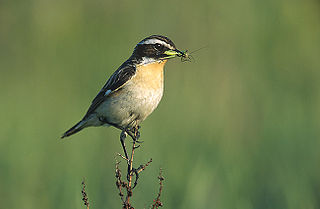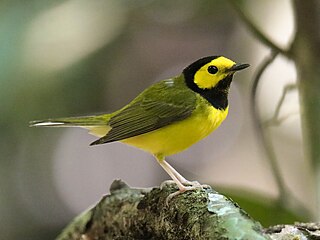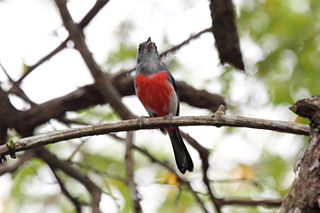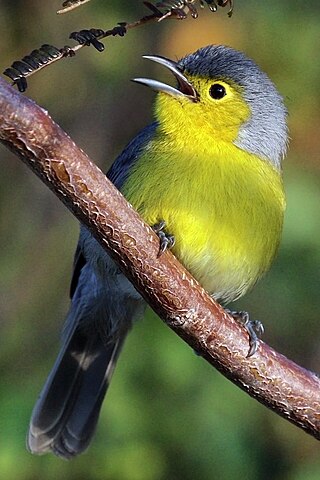
Chats are a group of small Old World insectivorous birds formerly classified as members of the thrush family (Turdidae), but following genetic DNA analysis, are now considered to belong to the Old World flycatcher family (Muscicapidae).

Icterids or New World blackbirds make up a family, the Icteridae, of small to medium-sized, often colorful, New World passerine birds. The family contains 108 species and is divided into 30 genera. Most species have black as a predominant plumage color, often enlivened by yellow, orange, or red. The species in the family vary widely in size, shape, behavior, and coloration. The name, meaning "jaundiced ones" comes from the Ancient Greek ikteros via the Latin ictericus. This group includes the New World blackbirds, New World orioles, the bobolink, meadowlarks, grackles, cowbirds, oropendolas, and caciques.

The New World warblers or wood-warblers are a group of small, often colorful, passerine birds that make up the family Parulidae and are restricted to the New World. The family contains 120 species. They are not closely related to Old World warblers or Australian warblers. Most are arboreal, but some, like the ovenbird and the two waterthrushes, are primarily terrestrial. Most members of this family are insectivores.

The hooded warbler is a New World warbler. It breeds in eastern North America across the eastern United States and into southernmost Canada (Ontario). It is migratory, wintering in Central America and the West Indies. Hooded warblers are very rare vagrants to western Europe.

The black-throated green warbler is a small songbird of the New World warbler family.

The mourning warbler is a small songbird of the New World warbler family. Mourning warblers are native to eastern and central North America as well as some countries in Central America. They are neotropical migrants and tend to be found in dense second growth forests. They are under the Wood-warbler category, which consists of arboreal and terrestrial colorful passerines. Wood warblers are in the order Passeriformes, which are perching birds including more than half of all bird species, and the family Parulidae which also includes the Common Yellowthroat, Black and White Warbler, Nashville Warbler, ovenbird, and American Redstart. They are very similar to the MacGillivray's Warbler in appearance, especially in females and immature birds, but their breeding range does not overlap into the west.

The Canada warbler is a small boreal songbird of the New World warbler family (Parulidae). It summers in Canada and northeastern United States and winters in northern South America.

The giant cowbird is a large passerine bird in the New World family Icteridae. It breeds from southern Mexico south to northern Argentina, and on Trinidad and Tobago. It may have relatively recently colonised the latter island. It is a brood parasite and lays its eggs in the nests of other birds.

The nine-primaried oscines is a group of bird families in the suborder Passeri (oscines) of the Passeriformes. The composition of the group has changed since the term was introduced but is now considered to consist of seven major families—Fringillidae, Emberizidae, Cardinalidae, Thraupidae, Passerellidae, Parulidae and Icteridae—plus some small families. When Fringillidae is omitted the remaining six families are referred to as the "New World" nine-primaried oscines.

The wrenthrush or zeledonia is a unique species of nine-primaried oscine bird which is endemic to Costa Rica and Panama.

The grey-throated chat is a species of bird in the family Cardinalidae, the cardinals or cardinal grosbeaks. It is found in Belize, Guatemala, and Mexico.

The green-tailed warbler, also known as the green-tailed ground-tanager, is a species of bird of the family Phaenicophilidae, the Hispaniolan tanagers. It is endemic to the island of Hispaniola which is shared by Haiti and the Dominican Republic.

The yellow-headed warbler is one of two species of bird in the Cuban warbler family Teretistridae. It is endemic to western Cuba.

The Cuban warblers are a genus, Teretistris, and family, Teretistridae, of birds endemic to Cuba and its surrounding cays. Until 2002 they were thought to be New World warblers, but DNA studies have shown that they are not closely related to that family. The family consists of two species, the yellow-headed warbler and the Oriente warbler. Both species are found in forest and scrub, with the yellow-headed warbler ranging in the west of the island and the Oriente warbler in the east. The Cuban warblers are 13 cm (5.1 in) long and have similar yellow and grey plumage.

The Oriente warbler is one of two species of bird in the Cuban warbler family Teretistridae. It is endemic to central and eastern Cuba.

The white-winged warbler, also called the white-winged ground-warbler or Hispaniolan highland-tanager, is a Vulnerable species of bird of the family Phaenicophilidae, the Hispaniolan tanagers. It is endemic to the island of Hispaniola which is shared by Haiti and the Dominican Republic.


















